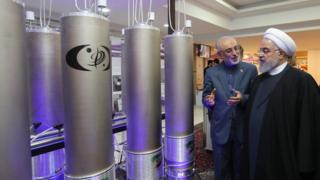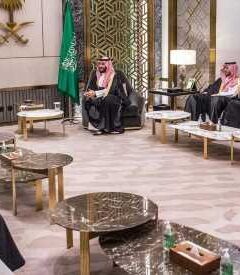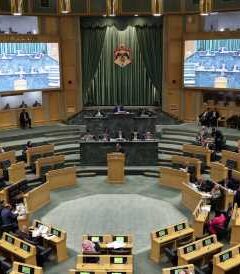Home » Middle East »
Why do the limits on Iran’s uranium enrichment matter?
Iran has announced it is lifting all limits on nuclear research – the latest step in scaling down its commitments made under a 2015 nuclear deal with world powers.
President Hassan Rouhani said from 6 September the country would begin developing centrifuges to speed up the enrichment of uranium.
Under the accord, Iran agreed to limit its sensitive nuclear activities and allow in international inspectors in return for the lifting of crippling economic sanctions.
Last year, the US withdrew from the deal and reimposed sanctions. Iran responded by abandoning two other key nuclear commitments in July.
What is enriched uranium?
Enriched uranium is produced by feeding uranium hexafluoride gas into centrifuges to separate out the most suitable isotope for nuclear fission, called U-235.
Low-enriched uranium, which typically has a 3-5% concentration of U-235, can be used to produce fuel for commercial nuclear power plants.
Highly-enriched uranium has a concentration of 20% or more and is used in research reactors. Weapons-grade uranium is 90% enriched or more.
Under the nuclear deal, Iran is allowed to enrich uranium only up to a 3.67% concentration, to stockpile no more than 300kg (660lbs) of the material, and to operate no more than 5,060 centrifuges.
Another part of the deal instructs Iran not to accumulate more than 130 tonnes of heavy water, which contains more hydrogen than ordinary water, and to redesign its heavy-water nuclear reactor at Arak. Spent fuel from a heavy-water reactor contains plutonium, which can be used in a nuclear bomb.
What has Iran done?
The global nuclear watchdog that monitors compliance with the deal, the International Atomic Energy Agency (IAEA), confirmed on 1 July that Iran had breached the 300kg enriched uranium stockpile limit.
A week later, inspectors verified that Iran had also begun enriching uranium to 4.5% concentration so that it could provide fuel for the Bushehr power plant – beyond the 3.67% cap.
The Tehran research reactor operates on fuel enriched to about 20%.
Why does this matter?
Experts at the Arms Control Association, a US-based advocacy group, said in July that the breach of the 300kg stockpile limit did not pose an immediate proliferation risk.
They noted that Iran would need roughly 1,050kg of 3.67% enriched uranium to be able to produce enough weapons-grade material for one bomb.
But the experts warned that if Iran resumed higher levels of enrichment, that would pose a more serious proliferation risk and shorten the “break-out time” – the time it would theoretically take to acquire enough fissile material for one bomb, if Tehran chose to do so.
That is because going from uranium’s natural state of 0.7% concentration of U-235 to 20% takes about 90% of the total effort required to get to weapons-grade.
Before the nuclear deal was implemented in 2016, Iran had a sufficient amount of 20% enriched uranium and number of centrifuges that its “break-out time” was estimated to be about two to three months.
The deal slowed the “break-out time” to at least a year. But any reversal of Iran’s commitments on uranium enrichment would see that start to shorten.
The steps Iran has taken could lead to it being found to be in “material breach” of the nuclear deal, which would allow other parties to “snap back” the UN and EU sanctions that were lifted.
No member of the UN Security Council would be able to veto such a move.
Why did Iran stop abiding by its commitments?
The Iranian economy has slumped since President Donald Trump withdrew from the deal in May 2018 and began reinstating sanctions. He said the deal was flawed and that he wanted to force Iran’s government to renegotiate the terms – something it refused to do.
The other parties to the deal – the UK, France, Germany, China and Russia – criticised Mr Trump’s decision and said they remained committed to the deal.
In May 2019, the White House stepped up pressure on Iran by ending exemptions from secondary sanctions for countries still buying Iranian oil.
It also ended exemptions for countries participating in deals under which Iran exchanged its surplus low-enriched uranium for un-enriched ore concentrate known as “yellowcake” and sold its surplus heavy water. Such transfers allowed Iran to continue production of both materials without exceeding the stockpile limits.
Iran’s President Hassan Rouhani subsequently said it would retaliate against the US sanctions by suspending its commitment to comply with the stockpile caps.
Officials noted that article 36 of the nuclear deal allows one party to “cease performing its commitments… in whole or in part” in the event of “significant non-performance” by other parties. They said the US violated the deal a year ago and that European countries had failed to deliver its promised economic benefits.
The European Union has set up a mechanism for facilitating trade, known as Instex, which essentially allows goods to be bartered between Iranian and foreign companies without direct financial transactions. It became operational on 29 June, but Iran said it did not meet its needs.
Does Iran want a nuclear bomb?
Iran insists it has never sought to develop such a weapon.
The international community does not believe that, pointing to evidence collected by the IAEA suggesting that until 2003 Iran conducted “a range of activities relevant to the development of a nuclear explosive device”. Some of those activities continued until 2009, according to the IAEA.
Last year, Israel displayed what it said were archives it secretly took from Iran which showed Iran continued to pursue nuclear weapons knowledge after 2015 – though Iran called the accusation “ridiculous”.
In January, the US intelligence community nevertheless assessed that Iran was “not currently undertaking the key nuclear weapons-development activities we judge necessary to produce a nuclear device”.
Source: Read Full Article



